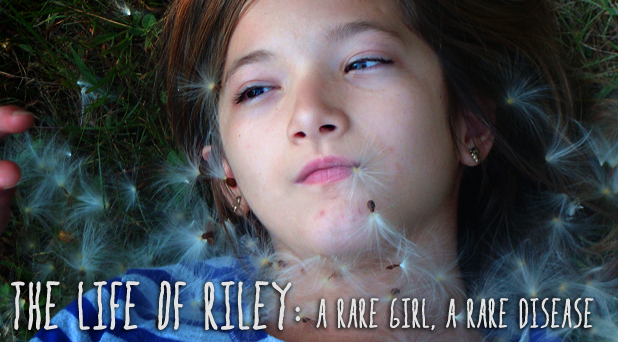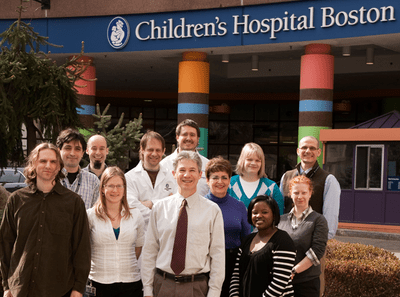Advertisement
Researchers Find Gene For 9-Year-Old Girl's 1-In-A-Million Disease

This is an update in the special CommonHealth/WBUR series, “The Life of Riley: A Rare Girl, A Rare Disease.” It’s the story of a remarkable 9-year-old girl born with a one-in-a-million disease that creates increasingly aggressive “lumps and bumps” on and in her body. The only treatment, so far, has been surgery. But right now, at Boston Children’s Hospital, Riley is trying an experimental drug that may — or may not — help her. See the full series here.
At dinner the other night, Riley Cerabona's parents tried to explain the very good news that would be officially announced by Boston Children's Hospital today: Researchers have discovered the gene mutation that causes CLOVES syndrome, Riley's exceedingly rare disease.
It didn't go very well. "We were trying to explain DNA to a 9-year-old," Riley's mother, Kristen Davis, said. "It really was a big flop." Finally, she said, "We boiled it down to: Remember in March of last year when we gave the researchers at the family conference your spit?"
Riley remembered. "Well, they've been looking at all the information in your spit and in tissue from your surgeries under the microscope, and they've also been looking at tissue from other people with CLOVES. And they've found a little missing piece of the puzzle in some of your cells."
Riley is too young to understand the full implications, but Kristen, who has known about the finding for days, says she has been feeling like a kid before Christmas. "There’s still a lot to learn," she said, but "I feel like it's a huge answer to the beginning of the mystery."
[module align="left" width="half" type="pull-quote"]'Science is a year’s worth of really hard work for about an hour’s worth of euphoria, followed by two or three sleepless nights.'[/module]
That answer also has potential implications for eventual treatments for Riley. The mutations at work — which occur as an embryo develops rather than being inherited from parents — have also been detected in some cancers, and drug companies are already working on treatments to block them. The gene paper, just out in the American Journal of Human Genetics, notes that "These same inhibitors might have therapeutic applications for individuals with CLOVES syndrome." Until this year's clinical trial of a drug called sirolimus at Children's, the only treatment for Riley has been one harrowing operation after another.
I spoke with Dr. Matthew Warman, director of the orthopedic research laboratories at Children's and the paper's senior author, and one comment of his made me laugh out loud. I asked him whether there had been one of those wonderful "Eureka" moments when his team realized they had indeed pinpointed the CLOVES gene, and he replied:
"We were incredibly excited obviously — but science is a very funny thing: Science is a year’s worth of really hard work for about an hour’s worth of euphoria, followed by two or three sleepless nights. You can't sleep because your brain is thinking about all the things you need to do to go to the next step."
(I stopped laughing, of course, as he continued, describing the very serious work ahead:) "I'm not talking about getting the paper written or filing intellectual property, I'm thinking about, 'Gee, now that we have this discovery, how can we extend our knowledge to help our patients? So how can we create an animal model that replicates what patients with CLOVES have? What drugs are out there already that might be amenable to patients with CLOVES? What other diseases could be caused by this gene? How is it that this mutation in fact is only present in a small fraction of cells within an affected tissue? So what is the protein doing that's signaling abnormally to innocent bystander, wild-type cells that is causing them to behave badly as well? And one more thing, the last thing: What mistake might I have made that might have produced a result that is incorrect?"

A bit on the methods: Dr. Warman's team, also led by Dr. Kyle Kurek, a pathologist and director of the pathology fellowship program at Children's, used a three-pronged approach. Thanks to freezers and the foresight of surgeons, they had tissue from "affected areas" — malformations or growths — from six CLOVES patients. Using cutting-edge DNA technology, they sequenced the entire "exome," the "non-junk" DNA known to code for actual genes. They also used a specialized array to look particularly at 77 genes likely to be involved in growth. And they looked at RNA, to see whether genes were highly expressed, or "turned on."
[module align="right" width="half" type="pull-quote"]'We’re so much smarter regarding what we should be doing today than we were half a year ago.'[/module]
The work was laborious, weeding through thousands of false positives and sequencing errors. To cut to the chase: One gene, known as PIK3CA, was found to be mutated in all six of the CLOVES patients. And PIK3CA, Dr. Warman said, had already been identified as a cancer-related gene — not that it caused cancer all by itself, but that it appeared able to make cancer more aggressive.
So what does this finding mean for Riley?
"Right off the bat," Dr. Warman said, "one could say that sirolumus, the drug being attempted in her, is downstream of this gene that’s mutated, so biologically inhibiting something that's functioning downstream could be beneficial. The only caveat there is that this gene is far upstream of where sirolimus works," so other biological pathways beyond the reach of the sirolimus may be affected. "So we really want to get closer and closer to the possible gene."
The cancer drugs under development could eventually provide powerful CLOVES treatments, he said, but first those drugs must be proven safe. With the gene now in hand, developing a mouse model of CLOVES could help clarify whether a drug strategy to block the gene's function even makes sense, he said.
The gene finding doesn't point to any immediate off-the-shelf drugs that might help CLOVES patients, he added, but "We’re so much smarter regarding what we should be doing today than we were half a year ago or a year ago, when we first got together with the families just to say, 'Let's see if we can solve this.'"
The genetics paper offers thanks at the end to families like Riley's, who helped make researchers' work easier by encouraging members of the CLOVES community to get patients' genes sequenced if they were interested.
The gratitude goes both ways. Kristen is feeling "super super grateful" — a rare double-adjective for her — and she's already done some typical "over-googling" of the mutation. She has so many questions for Dr. Cameron Trenor, who is overseeing Riley's participation in the clinical trial, that they can't be summed up in email. Please stay tuned...
Further reading: "Do I have the strength to be a marathon parent?" Kristen's eloquent post on the Children's blog, Thriving.
This program aired on May 31, 2012. The audio for this program is not available.
